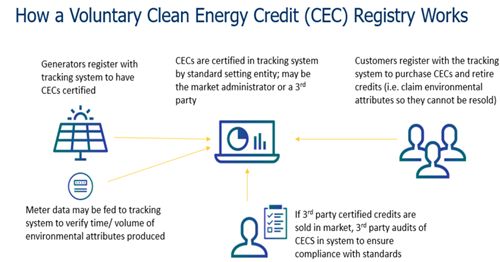On January 26, 2022, the Ontario government announced its intention to develop a Clean Energy Credit (CEC) registry.1 The registry will be a voluntary certification registry focused on encouraging corporations to further invest in their environmental and sustainable initiatives and attempts to incentivize investment in non-emitting electricity generation.
Corporations will be able to obtain certificates that represent one megawatt-hour (MWh) of electricity generated by a non-emitting source such as solar, wind, bio energy, hydroelectricity and nuclear power.2 Through the registry, corporations will be able to authenticate and register their energy consumption derived from non-emitting sources. These credits will be able to be voluntarily purchased, traded and retired to meet the corporate sustainability goals and offset the carbon emissions of the voluntary corporations within Ontario.
Ontario would not be the first to implement such an initiative. Voluntary CEC registries have been operating within the United States such as Ohio, Pennsylvania, Illinois, Indiana, Wisconsin and the New England states, under the Midwest Renewable Energy Tracking System and the North American Renewables Registry.3
HOW THE CEC REGISTRY WILL WORK AND CERTIFY THE CREDITS
The Independent Electricity System Operator (IESO) is working in partnership with the Ministry of Energy to establish the ongoing operation and management of the CEC registry. The collection of CECs will be tracked in four ways, as illustrated in the IESO figure4 below:

Image credit: Independent Electricity System Operator – Clean Energy Credits Engagement Plan
CEC REGISTRY DESIGN AND ENGAGEMENT
While the detailed design of the CEC registry is ongoing, the IESO confirmed that the options to support management of renewable and clean energy credits will be based on the following principles:
- Domestic: The registry should include renewable and clean energy credits for electricity generated and consumed in Ontario. The initial design of the registry should be scoped to enable the trading of credits within Ontario.
- Voluntary: The purchase of credits from the registry would be voluntary.
- Customer choice: Evaluate market demand and create a variety of products to satisfy that demand.
- Monetize investments made: Credit offerings should include existing non-emitting generation with best efforts made to enable proceeds from CEC sales to flow to ratepayers.
- Future Proof: Build the registry to offer flexibility and the potential for future expansion to other products or markets, and to consider how the registry might incentivize future investment in new clean or renewable generation, when that power is needed.
The IESO encourages stakeholders to engage in the development of this clean energy initiative between February and June 2022. The IESO's findings and recommendations will be published in the CEC market Recommendation Report by July 4, 2022.5 The Ministry of Energy intends to make the CEC registry operational by January 2023.
IMPLICATIONS OF THE CEC REGISTRY FOR ONTARIO
We anticipate the following topics to be considered during the design and engagement for the CEC registry:
- The inclusion of nuclear energy and potential future investment in Ontario's nuclear industry.
- The extent to which the CEC registry will attract new investment in renewable energy generation in Ontario (in addition to enabling proceeds from existing non-emitting generation).
- The certification standard the CEC registry will use to verify the CECs.
As with any renewable energy or carbon offset credit registry, the Ministry of Energy will need to ensure the authenticity and verification of the CECs in its registry. Verifying CECs typically involves, among other things, ensuring additionality and avoiding double counting. Additionality refers to the generation of the credits as a determining factor in pursuing the project and double counting refers to incremental carbon reduction and ensuring that two or more entities are not claiming credit for the same MWh of electricity generated or unit of carbon reduced.6
Corporate and institutional renewable energy deals for renewable energy projects have totaled 1,703 MW since 2019, with most projects occurring in Alberta due to its deregulated electricity market.7 With proper design, the CEC registry may spark increased investment in clean energy in Ontario.
Footnotes
1 Government of Ontario, New Ontario Clean
Energy Registry Will Make Province Even More Attractive for
Investment (26 January 2022), Ontario Newsroom online: (https://news.ontario.ca/en/release/1001486/new-ontario-clean-energy-registry-will-make-province-even-more-attractive-for-investment
).
2 Ibid.
3 Ibid; Independent Electricity System Operator,
Clean Energy Credits (last updated January 26, 2022), IESO
online: (https://ieso.ca/en/Sector-Participants/Engagement-Initiatives/Engagements/Clean-Energy-Credits
) [IESO]; Midwest Renewable Energy Tracking System, RPS and
Goals (last accessed 27 January 2022), MRETS online: (https://www.mrets.org/resources/statutes/);
North American Renewables Registry, APX Registries (last
accessed 27 January 2022), APX online: (https://apx.com/about-nar/ ).
4 IESO.
5 Ibid.
6 Government of Canada, Carbon pollution pricing:
options for a Federal Greenhouse Gas Offset System (last
updated September 2, 2019), Canada online: (https://www.canada.ca/en/environment-climate-change/services/climate-change/pricing-pollution-how-it-will-work/federal-offset-system.html
).
7 Corporate Renewable Energy Deals in Canada (Q4
2021) (last accessed 27 January 2022), Business Renewables
online: (https://businessrenewables.ca/deal-tracker
).
The content of this article is intended to provide a general guide to the subject matter. Specialist advice should be sought about your specific circumstances.



